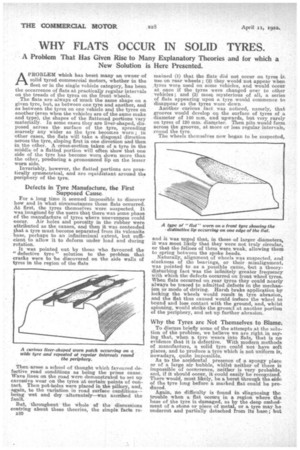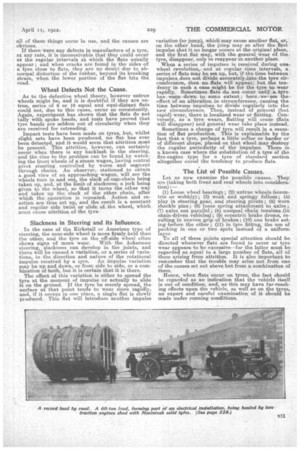WHY FLATS OCCUR IN SOLID TYRES.
Page 14

Page 15

If you've noticed an error in this article please click here to report it so we can fix it.
A Problem That Has Given Rise to Many Explanatory Theories and for which a New Solution is Here Presented.
APROBLEM 'which has beset many an owner of solid tyred commercial motors, -whether in the fleet or in the single vehicle category, has been the occurrence of flats at practically regular intervals on the treads of the tyres on the front wheels.
The flats are always of much the same shape on a given tyre, but, as between one tyre and another, and as between the tyres on one vehicle and the tyres on another (even when the vehicles are of the same make and type), the shapes of the flattened portions vary materially. In some cases they are liver-shaped, din. posed across the surface of the tyre, spreading scarcely any wider as the tyre becomes worn . ' in other cases, the flats will take a diagonal direction across the tyre sloping first in one direction and then in the other. 'A-cross-section taken of a tyre in the middle of a flatted portion will often show that one side of the tyre has become worn down more than the other, producing a pronounced lip on the lesser worn side, Invariably, however, the flatted portions are practically symmetrical, and are equidistant around the periphery of the tyre.
Defects in Tyre Manufacture, the First Supposed Cause.
For a long time it seemed impossible to discover how and in what circumstance's these flats occurred. At first, the tyres themselves were suspected. It was imagined iby the users that there was some phase of the manufacture of tyres where unevenness could occur. Air holes and porosity in the rubber were attributed as the causes, and then it was contended that a tyre must become separated from its vulcanite base, perhaps to an infinitesimal extent, but sufficient to allow it to deform under load and during rotation.
It was pointed out by those who favoured the " defective tyre' solution to the problem that cracks were to be discovered on the side walls of tyres in the region of the flats
Then-arose a school of thought which favoured defective road conditions as being the prime cause. Wave lines on the road were demonstrated to set up excessive wear on the tyres at certain points of ,eontact. Then pot-holes were placed in the eillory, and, again, to the variation in road surface conditions-being wet and day alternately—seas ascribed the fault.
But, throughout the whole of the discussions centring about these theories, the simple facts reel
mained (1) that the fiats did not occur on tyres in use on rear wheels; (2) they would not appear when :tyres were used on some vehicles, and would emir at once if the tyres were changed over to other vehicles ; and (3) most mysterious of all) a series of flats appearing upon a tyre would commence to disappear as the tyres wore down. Another curious fact was noticed, namely, that grooves would develop on the surface of tyres of a diameter of 140 mm. and upwards, but very rarely on tyres of 120 mm. diameter. Then pits would form twross the grooves, at more or less regular intervals, round the tyre.
The wheels themselves now began to be suspected,
and it was urged that, in those of larger diameters, it was most likely that they were not truly circular, or that the felloe,s of them were weak, allowing them to spring between the spoke heads.
Naturally, alignment of wheels was suspected, and .slackness of the bearings, or their misalignment, was pointed to as a possible cause, but a theorydisturbing fact was the infinitely greater frequency with which the defects occurred on front wheel tyres. When flats occurred on rear tyres they could nearly always be traced to admitted defects in the mechanism or mode of driving. Harsh brake application by locking the wheels would result in tyre a.brasion, and the flat thus caused would incline the wheel to bound and lose contact with the ground, and, whilst spinning, would strike the ground at another portiou of the periphery, and set up further abrasion.
Why the Tyres are Not Themselves to Blame.
To dismiss briefly some of the attempts at the solution of the problem, we believe we are right in saying that, -when a tyro wears into flats, that is nu evidence that it is defective. With modern methods of manufacture, a solid tyre could not have soft places, and to produce a tyre which is not uniform is, nowadays, quite impossible. As to tie accidental presence of a spongy place or of a large air bubble, whilst neither of these is impossible of occurrence, neither is very probable, and, if it should occur, it could easily be recognized. There would, most likely, be a burst through the aide of the tyre long before a marked flat could be produced.
Again, no difficulty is found in diagnosing the trouble when a flat occurs in a region where the base of the tyre is damaged, as by the deep embedment of a stone or piece of metal, or a tyre maybe undercut and partially detached from its base; but all of these things occur in use, and the causes are obvious.
If there were any defects in manufacture of a tyre, at any rate, it is inconceivable that they could occur at the regular intervals it which the flats usually appear ; and when cracks are found in the sides of a tyre close to flats, they are no doubt due to abnormal distortion of the rubber, beyond its breaking strain, when the lower portion of the flat hits the road.
Wheel Defects Not the Cause.
As to the defective wheel theory, however untrue wheels might be, and it is doubtful if they are untrue, series of 8 or 10 equal and equi-distant flats could not, due to this cause, occur so consistently. Again, experiment has shown that the flats do not tally with spoke heads, and tests have proved that tyre bands are seldom out of circularity when they are received for retreading.
Impact tests have been made on tyres, but, whilst slight sets have been produced, no flat has ever been detected, and it would seem that attrition must be present. This attrition, however, can certainly occur when there is any backlash in the steering, and the clue to the problem can be found by watching the front wheels of a steam wagon, having central pivot steering . controlled by worm and segment through chains. An observer, stationed to obtain a good view of an approaching wagon, will see the -wheels turn in and out, the slack of one.chain being taken up, and, at the limit of slackness i a jerk being given to the wheel, so that it turns the other way and takes up the slack of the other chain, after which the operation is repeated. Action and reaction are thus set up, and the result is a constant and regular side twist or slide of,the wheel, which must cause attrition of the tyre
Slackness in Steering and its Influence.
In the case of the Kirkstall or American type of steering, the near-side wheel is more firmly held than the other, and the tyre on the off-side wheel often shows signs of more wear. With• the Ackerman steering, slackness can develop in the joints, and there will be caused a variation, or a series of variations, in the direction and nature of the rotational impulse received by a tyre. An impulse variation may be up and down, or from side to side, or a combination of both, but it is certain that it is there.
The effect of this variation is either to spread the tyre at the moment of impulse or actually to slide it on the ground. If the tyre be merely spread, the surface at that point tends• to wear more rapidly, and, if it occurs in one place, a single flat is slowly produced. This flat will introduce another impulse
variation (or jump), which may cause another fiat, or on the other hand, the jump may so alter the fixst impulse that it no longer occurs at the original place, and the first flat may, with the general wear of the tyre, disappear, only to reappear in another place.
When a series of impulses is received during one, wheel revolution, and at regular time intervals, series of fiats may be set up, but, if the time between impulses does not divide accurately,into the tyre circumference, then uo flats will appear; but the tendency in such a case might be for the -tyre to wear rapidly. Sometimes flats do not occur until a tyte has worn down to some extent ; here -we-see the effect of an alteration in circumference, causing the time between impulses to divide regularly into the new circumference. Then, instead of general (but rapid) wear, there is localized wear or flatting. Conversely, as a tyre wears, flatting will cease (flats will disappear) and general wear take place instead.
Sometimes a change of tyre will result in a cessation of flat production. This is explainable by the fact that a tyre, perhaps a little softer or harder or of different shape, placed on that wheel may destroy the regular periodicity of the impulses. There is A. known case where the substitution of a tyre of the fire-engine type for a tyre of standard section altogether cured the tendency to produce flats.
The List of Possible Causes.
Let us now examine the possible causes. They are (taking both front and rear wheels into considers,: tion)
(1) Loose wheel bearings; (2) untrue wheels (eccentric or wobbly); (3) weak and springy felloes ; (4) play in steering gear, and steering pivots ; (5) worn shackle pins ; (6) loose spring attachment to axles ; (7) axles not parallel ; (8) unequal chain tensions (in chain-driven vehicles); (0) eccentric brake drums, resulting in uneven grip of brakes; (10) one brake acting before the other ; (11) in tyre fitting, the use of packing in one or two spots instead of a uniform layer.
To all of these points special attention should be directed whenever flats are found to occur or tyre wear appears -to be excessive—for the latter must be regarded as equal to a large number of fiats, all of them arising from attrition. It is also important to remember that the trouble may arise not from one of the causes set out above but from a combination of them.
Heece, when flats occur on tyres, the fact should be regarded as an indication that the vehicle itself is out of condition, and, as this may have far-reaching effects upon the vehicle, as well as on the tyres, an expert and careful examination of it should be made under running conditions.
































